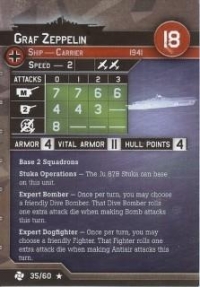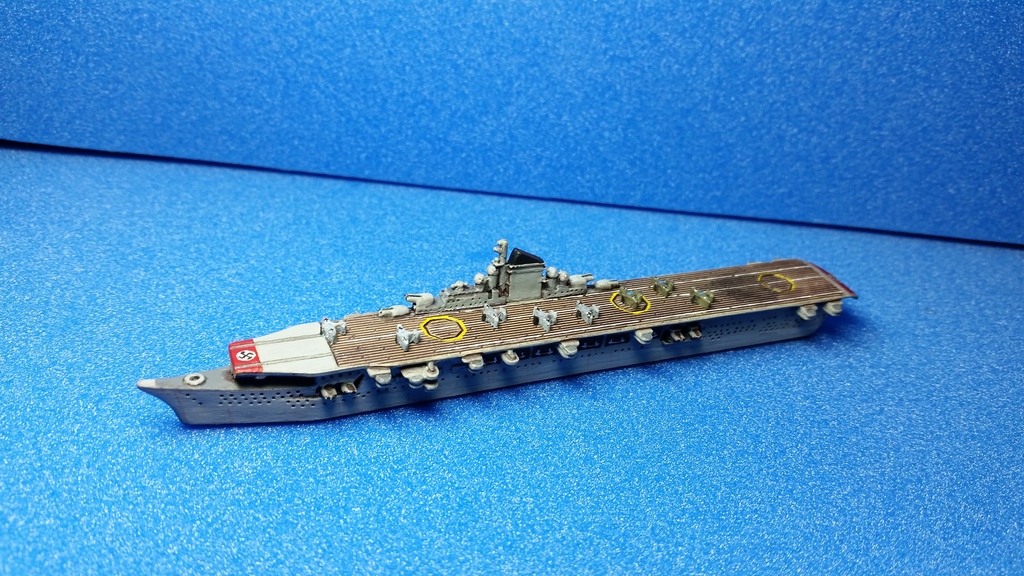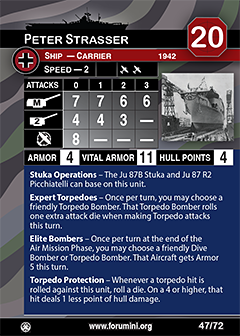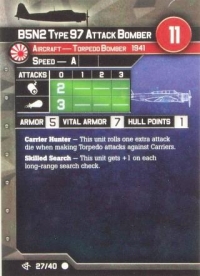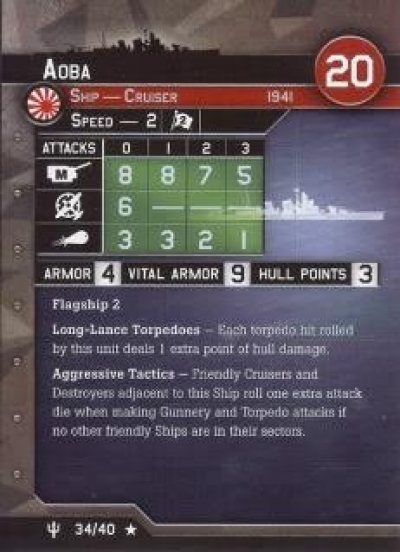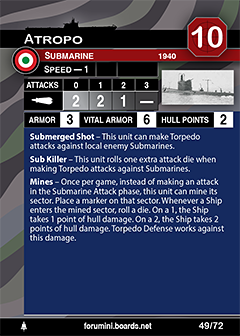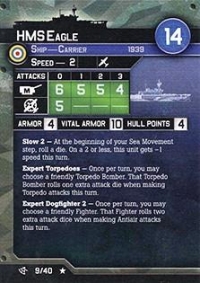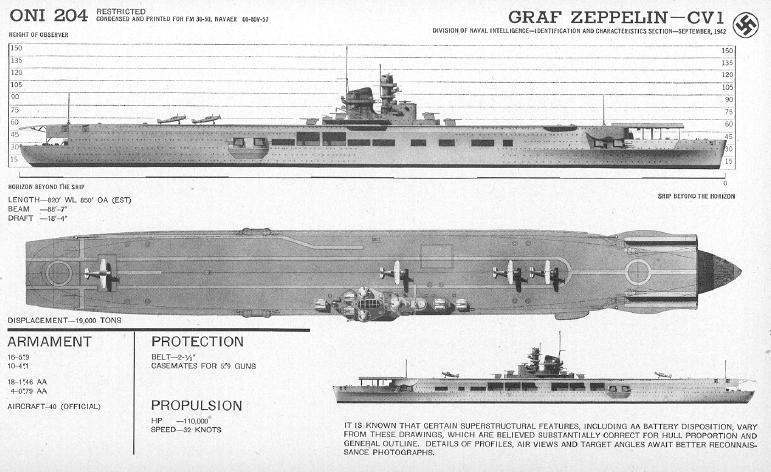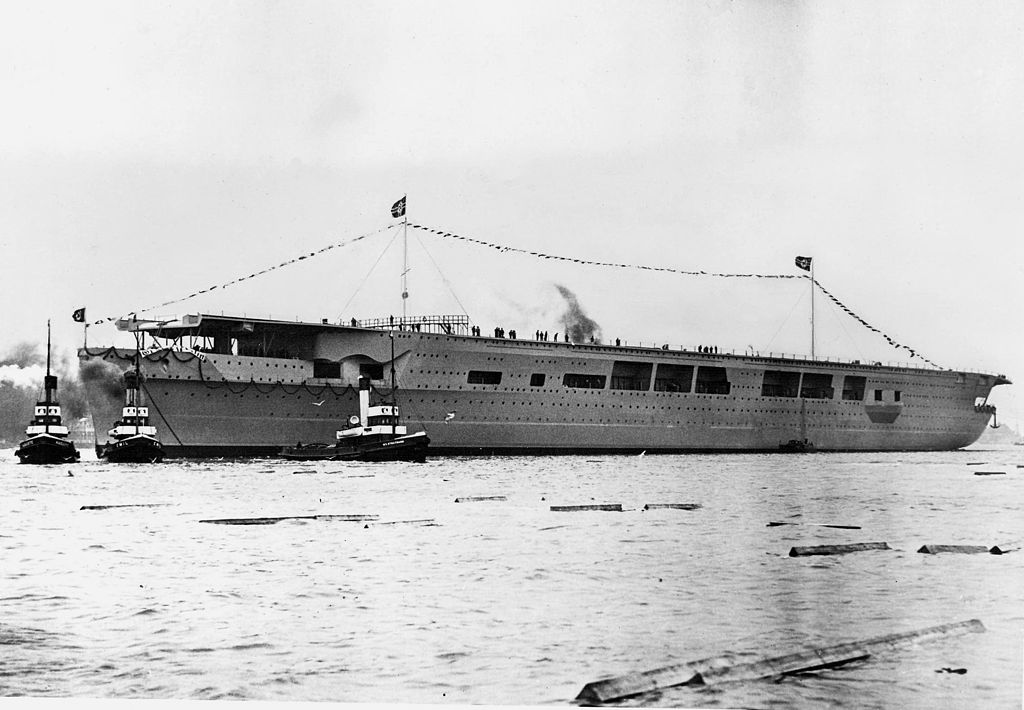Prototype: The German aircraft carrier Graf Zeppelin was the lead ship in a class of two carriers of the same name ordered by the Kriegsmarine. She was the only aircraft carrier launched by Germany and represented part of the Kriegsmarine's attempt to create a well-balanced oceangoing fleet, capable of projecting German naval power far beyond the narrow confines of the Baltic and North Seas. The carrier would have had a complement of 42 fighters and dive bombers.
Construction on Graf Zeppelin began on 28 December 1936, when her keel was laid down at the Deutsche Werke shipyard in Kiel. Named in honor of Graf (Count) Ferdinand von Zeppelin, the ship was launched on 8 December 1938, and was 85% complete by the outbreak of World War II in September 1939. Graf Zeppelin was not completed and was never operational due to shifting construction priorities necessitated by the war. She remained in the Baltic for the duration of the war; with Germany's defeat imminent, the ship's custodian crew scuttled her just outside Stettin in March 1945. The Soviet Union raised the ship in March 1946, and she was ultimately sunk in weapons tests north of Poland 17 months later. The wreck was discovered by a Polish survey ship in July 2006.
Construction on Graf Zeppelin began on 28 December 1936, when her keel was laid down at the Deutsche Werke shipyard in Kiel. Named in honor of Graf (Count) Ferdinand von Zeppelin, the ship was launched on 8 December 1938, and was 85% complete by the outbreak of World War II in September 1939. Graf Zeppelin was not completed and was never operational due to shifting construction priorities necessitated by the war. She remained in the Baltic for the duration of the war; with Germany's defeat imminent, the ship's custodian crew scuttled her just outside Stettin in March 1945. The Soviet Union raised the ship in March 1946, and she was ultimately sunk in weapons tests north of Poland 17 months later. The wreck was discovered by a Polish survey ship in July 2006.
Class History: The Graf Zeppelin-class aircraft carriers were four German Kriegsmarine aircraft carriers planned in the mid-1930s by Grand Admiral Erich Raeder as part of the Plan Z rearmament program after Germany and Great Britain signed the Anglo-German Naval Agreement. They were planned after a thorough study of Japanese carrier designs; nevertheless, German naval architects ran into difficulties due to lack of experience in building such vessels, the situational realities of carrier operations in the North Sea and the lack of overall clarity in the ships' mission objectives. This lack of clarity led to features either eliminated from or not included in American and Japanese carrier designs. These included a complement of cruiser-type guns for commerce raiding and defense against British cruisers. American and Japanese carriers, designed along the lines of task-force defense, used supporting cruisers for surface firepower, which allowed flight operations to continue without disruption and kept carriers out of undue risk of damage or sinking from surface action.
A combination of political infighting between the Kriegsmarine and the Luftwaffe, disputes within the ranks of the Kriegsmarine itself and Adolf Hitler's waning interest all conspired against the carriers. A shortage of workers and materials slowed construction still further and, in 1939, Raeder reduced the number of ships from four to two. Even so, the Luftwaffe trained its first unit of pilots for carrier service and readied it for flight operations. With the advent of World War II, priorities shifted to U-boat construction; one carrier, Flugzeugträger B, was broken up on the slipway while work on the other, Flugzeugträger A (christened Graf Zeppelin) was continued tentatively but suspended in 1940. The air unit scheduled for her was disbanded at that time.
The role of aircraft in the Battle of Taranto, the pursuit of the German battleship Bismarck, the attack on Pearl Harbor and the Battle of Midway demonstrated conclusively the usefulness of aircraft carriers in modern naval warfare. With Hitler's authorization, work resumed on the remaining carrier. Progress was again delayed, this time by the demand for newer planes specifically designed for carrier use and the need for modernizing the ship in light of wartime developments. Hitler's disenchantment with the performance of the Kriegsmarine's surface units led to a final stoppage of work. The ship was captured by the Soviet Union at the end of the war and sunk as a target ship in 1947
A combination of political infighting between the Kriegsmarine and the Luftwaffe, disputes within the ranks of the Kriegsmarine itself and Adolf Hitler's waning interest all conspired against the carriers. A shortage of workers and materials slowed construction still further and, in 1939, Raeder reduced the number of ships from four to two. Even so, the Luftwaffe trained its first unit of pilots for carrier service and readied it for flight operations. With the advent of World War II, priorities shifted to U-boat construction; one carrier, Flugzeugträger B, was broken up on the slipway while work on the other, Flugzeugträger A (christened Graf Zeppelin) was continued tentatively but suspended in 1940. The air unit scheduled for her was disbanded at that time.
The role of aircraft in the Battle of Taranto, the pursuit of the German battleship Bismarck, the attack on Pearl Harbor and the Battle of Midway demonstrated conclusively the usefulness of aircraft carriers in modern naval warfare. With Hitler's authorization, work resumed on the remaining carrier. Progress was again delayed, this time by the demand for newer planes specifically designed for carrier use and the need for modernizing the ship in light of wartime developments. Hitler's disenchantment with the performance of the Kriegsmarine's surface units led to a final stoppage of work. The ship was captured by the Soviet Union at the end of the war and sunk as a target ship in 1947
Country: Germany is a Western European country with a landscape of forests, rivers, mountain ranges and North Sea beaches. It has over 2 millennia of history. Berlin, its capital, is home to art and nightlife scenes, the Brandenburg Gate and many sites relating to WWII. Munich is known for its Oktoberfest and beer halls, including the 16th-century Hofbräuhaus. Frankfurt, with its skyscrapers, houses the European Central Bank.
Item created by: Lethe on 2015-05-31 17:46:30. Last edited by gdm on 2019-04-19 17:53:49
If you see errors or missing data in this entry, please feel free to log in and edit it. Anyone with a Gmail account can log in instantly.
If you see errors or missing data in this entry, please feel free to log in and edit it. Anyone with a Gmail account can log in instantly.


